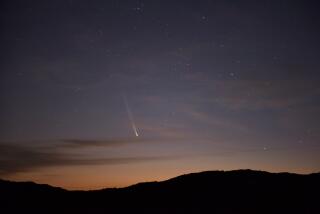NASA orbiters watch as comet flies safely past Mars
Comet Siding Spring sailed past Mars on Sunday, coming 10 times closer to the Red Planet than any comet on record has come to Earth.
At the time of the comet’s closest approach at 11:27 a.m., it was just 87,000 miles from Mars. That’s less than half the distance between Earth and the moon.
Jim Green, director of planetary science for NASA, said the close encounter between planet and comet was a once-in-a-million-year event.
Comet Siding Spring traveled a long way to make its rendezvous with Mars. Its journey began a million years ago and billions of miles away in the Oort cloud, an icy region at the very outer edge of the solar system.
Scientists don’t know what sent the comet hurtling toward the inner solar system -- perhaps the gravity of a passing star bumped it into its million-year orbit. They do think, however, that this is the closest the comet has ever come to the sun.
The comet will continue to sail toward the sun for a few more days before its orbit takes it on another million-year trip toward the outer solar system.
When the comet was discovered in January 2013, NASA officials were concerned that speeding dust particles in the comet’s tail might damage the expensive and delicate spacecraft in orbit around Mars.
Computer models showed this was unlikely, but as a precaution, NASA officials made sure Odyssey, MAVEN and the Mars Reconnaissance Orbiter (MRO) were hiding on the far side of the planet 80 minutes after the comet’s closest approach. This was deemed to be the time of highest risk to the orbiters.
The duck and cover strategy worked out, and NASA said all three orbiters are safe and sound.
“The spacecraft performed flawlessly throughout the comet flyby,” said MRO project manager Dan Johnston, of NASA’s Jet Propulsion Laboratory in a statement. “It maneuvered for the planned observations of the comet and emerged unscathed.”
Bruce Jakosky of the University of Colorado, Boulder, and the principal investigator of the MAVEN mission also had good news to report. “We’re glad the spacecraft came through, we’re excited to complete our observations of how the comet affects Mars, and we’re eager to get to our primary science phase,” he said in a statement.
It will probably take scientists several months to start interpreting the data collected during this flyby, but comet enthusiasts should still keep their eyes on the Internet for the next few days. In a press event last week, officials said the public can expect to see the first comet pictures from the Mars orbiters and probes on Monday or Tuesday.
We can hardly wait!
Science rules! Follow me @DeborahNetburn and “like” Los Angeles Times Science & Health on Facebook.







